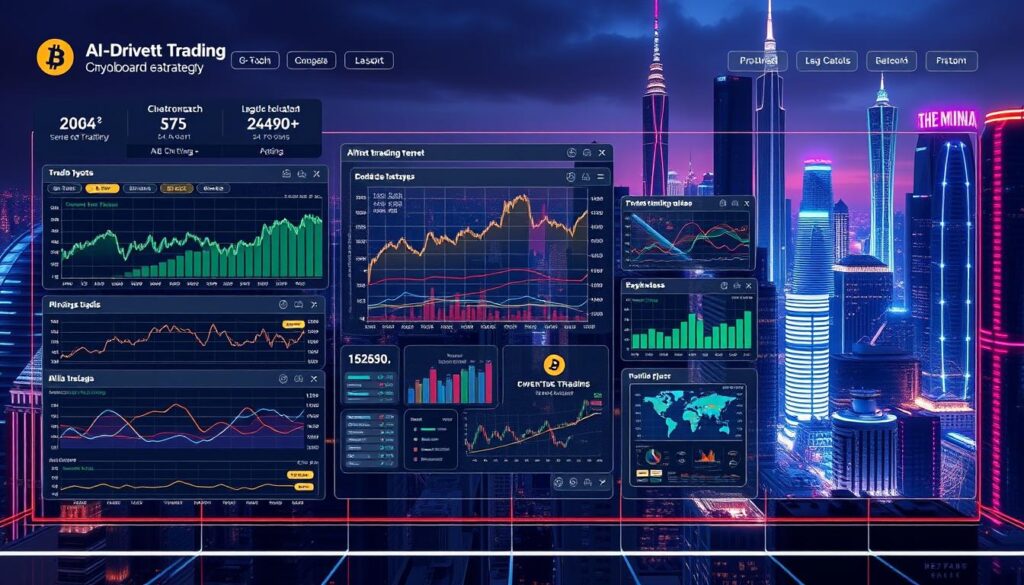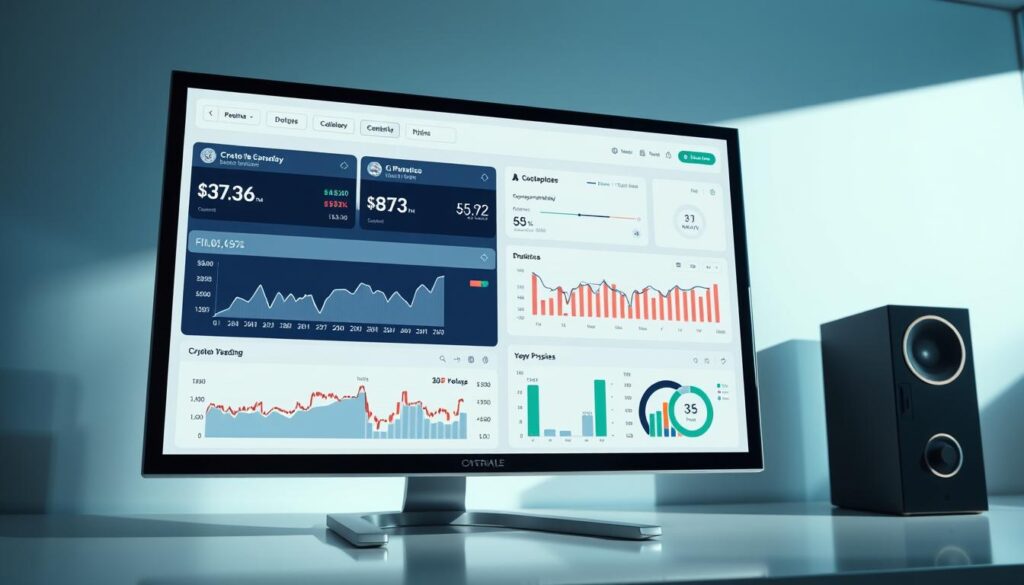Now Reading: Effective AI Crypto Trading Strategies That Actually Work
- 01
Effective AI Crypto Trading Strategies That Actually Work
Effective AI Crypto Trading Strategies That Actually Work

The digital asset landscape has transformed dramatically with advanced technology integration. Modern investors seek tools that provide competitive advantages in fast-moving markets.
Institutional adoption signals a major shift in market approaches. Approximately 60% of professional investment firms now incorporate automated signal generation into their decision-making processes.
These sophisticated systems analyze vast amounts of data with incredible speed. They execute transactions in milliseconds, capturing opportunities that human traders often miss due to natural limitations.
This guide explores proven methodologies that leverage cutting-edge technology. Readers will discover how data-driven approaches minimize emotional bias while maximizing profit potential in volatile conditions.
Whether you’re new to digital assets or an experienced participant, this resource provides essential knowledge. It covers platforms, tools, and best practices for implementing successful automated approaches.
Key Takeaways
- Institutional investors increasingly rely on automated signal generation
- Technology-driven systems execute transactions with millisecond precision
- Data analysis helps reduce emotional decision-making in volatile markets
- Speed advantages create opportunities beyond human capability
- Proper implementation requires understanding platform features and risk management
- Methodologies should align with individual investment goals and experience levels
- Continuous learning adapts strategies to evolving market conditions
Introduction to AI-Powered Crypto Trading
Advanced computational systems are revolutionizing how market participants approach digital assets. These intelligent platforms leverage sophisticated algorithms to process massive amounts of market information.

The table below highlights key differences between traditional methods and modern automated approaches:
| Feature | Traditional Trading | AI-Powered Trading |
|---|---|---|
| Operation Hours | Limited by human capacity | 24/7 continuous monitoring |
| Decision Basis | Emotional and analytical mix | Pure data-driven analysis |
| Execution Speed | Seconds to minutes | Millisecond responses |
| Emotional Factors | Significant influence | Completely eliminated |
These systems operate continuously without fatigue. They capture opportunities that human traders might miss during off-hours.
Intelligent platforms analyze real-time sentiments from various sources. This provides deeper insights into market dynamics affecting price movements.
The technology helps participants make better decisions by removing psychological biases. For those interested in specific algorithm implementations, detailed resources are available.
Both newcomers and experienced traders can benefit from these advanced tools. The automated approach represents a significant evolution in digital asset management.
The Rise of AI in the Cryptocurrency Market
The past decade witnessed the cryptocurrency sector mature from a niche interest into a global financial force. This growth brought unprecedented opportunities alongside significant price swings that challenge even seasoned participants.

Intelligent systems have emerged as a game-changing response to this volatility. These platforms provide sophisticated tools to analyze market trends and identify patterns with greater accuracy.
Traditional methods often struggle with the speed of digital asset markets. Prices can shift dramatically within minutes based on news and sentiment.
Modern systems process vast amounts of information from multiple sources simultaneously. The table below shows the diverse data these platforms analyze for comprehensive insights:
| Data Source | Primary Focus | Impact on Analysis |
|---|---|---|
| Price Charts | Historical & Real-time Movement | Identifies patterns and support/resistance levels |
| Social Media & News | Public Sentiment | Gauges market mood and potential reaction triggers |
| Blockchain Analytics | On-chain Activity | Provides insights into network health and large holder movements |
| Trading Volume | Market Participation | Confirms the strength of a price trend |
This capability represents a major shift in approach. It moves from reactive decision-making to proactive, data-driven strategies that adapt in real time.
Adoption rates continue to climb as more traders recognize the advantages. These tools have become essential for those seeking a competitive edge in sophisticated markets.
Understanding Trading Bots in Crypto
Systematic automation tools represent a fundamental shift in how portfolio management occurs. These programs operate continuously, capturing opportunities around the clock.

Modern participants rely on these assistants to maintain consistent market presence. The technology eliminates manual monitoring requirements while enhancing performance.
Key Features and Automation Processes
Effective trading bots incorporate sophisticated risk management tools. They analyze market trends and execute positions based on predefined conditions.
Automation enables precise order placement at optimal moments. These systems manage multiple assets across various platforms simultaneously.
| Bot Type | Primary Function | Best For | Risk Level |
|---|---|---|---|
| Grid Bots | Profit from price fluctuations | Range-bound markets | Medium |
| DCA Bots | Systematic asset accumulation | Long-term investing | Low |
Benefits Over Traditional Trading Methods
Programmatic assistants operate without emotional interference. They execute trades with speed and consistency that manual approaches cannot match.
These tools provide 24/7 market monitoring and instant response capabilities. Backtesting features allow strategy validation before live implementation.
Multi-exchange functionality creates arbitrage opportunities. Portfolio management becomes more efficient through automated rebalancing and position sizing.
AI Crypto Trading Strategies that actually work: A Detailed Overview
Various systematic approaches have emerged as effective tools for navigating volatile conditions. These methodologies leverage computational power to identify patterns and opportunities across different timeframes.
Trend Following, Breakout, and Mean Reversion
Trend following strategies capitalize on sustained directional movements. Systems analyze historical price movements to detect upward or downward trends.
Breakout methodologies focus on identifying when assets move beyond key levels. This approach signals potential significant price changes in the market.
Mean reversion techniques exploit the tendency of prices to return to average levels. This enables optimal buy sell timing based on statistical deviations.
| Strategy Type | Primary Focus | Key Advantage | Best Market Condition |
|---|---|---|---|
| Trend Following | Directional price movements | Early trend identification | Strong trending markets |
| Breakout | Price level breaches | Reduces false signals | Volatile breakout periods |
| Mean Reversion | Statistical averages | Buy low/sell high opportunities | Range-bound conditions |
| Arbitrage | Price differences | Multiple market scanning | Inefficient pricing |
| Sentiment Analysis | Market emotions | Predicts sentiment-driven moves | News-driven volatility |

Arbitrage and Sentiment Analysis Techniques
Arbitrage techniques capitalize on price differences across exchanges. Rapid scanning identifies gaps before they close in the market.
Sentiment analysis evaluates emotional factors influencing asset values. This approach reads various sources to gauge public opinion about price directions.
Combining multiple approaches creates diversified trading strategies. This works effectively across different conditions and timeframes.
Evaluating Trading Platforms and Bots
Selecting the right automated system requires careful assessment of several critical platform characteristics. This process ensures your chosen tools align with both your investment objectives and risk management preferences.
Compatibility with your preferred marketplaces represents a fundamental consideration. Not all automated tools support every major marketplace, so verification is essential.
Supported Exchanges and Fee Structures
Integration with established marketplaces like Binance, Coinbase, and Kraken provides significant operational advantages. These connections enable seamless position management across multiple venues.
Fee arrangements vary considerably between different service providers. Some charge monthly subscriptions while others utilize performance-based models. Understanding complete cost structures prevents unexpected expenses from reducing overall returns.
User Interface and Customer Support
Interface design dramatically impacts user experience, particularly for those new to automated systems. Clear, intuitive dashboards simplify configuration and monitoring processes.
Reliable assistance services become crucial during technical issues or configuration questions. The best platforms offer comprehensive support through multiple channels including live chat and detailed documentation.
Security measures and customization options complete the evaluation checklist. These elements ensure both safety and adaptability to changing market conditions.
Customization and Backtesting Capabilities
Before deploying capital in live markets, experienced investors rely on critical validation processes. These features separate basic automated systems from sophisticated portfolio management tools.
Testing approaches with historical information builds confidence in your chosen methodology. This rehearsal phase identifies potential weaknesses before real capital enters the equation.
Testing Strategies with Historical Data
Backtesting allows you to validate performance using past market conditions. This process provides empirical evidence that a particular approach has worked effectively previously.
Comprehensive testing should cover different timeframes and volatility levels. The table below shows essential backtesting features to evaluate:
| Feature Type | Basic Platforms | Advanced Systems |
|---|---|---|
| Timeframe Options | Limited periods | Multiple years available |
| Market Condition Testing | Bull markets only | Bull, bear, and sideways markets |
| Performance Metrics | Basic profit/loss | Win rates, drawdowns, risk ratios |
| Parameter Optimization | Manual adjustments | Automated optimization tools |
Adjusting Parameters for Unique Trading Goals
Customization options allow you to tailor automated systems to your specific needs. This flexibility ensures the tool aligns with your risk tolerance and investment objectives.
Key adjustment areas include position sizing, entry/exit conditions, and indicator preferences. The best platforms offer visual builders and scripting options for both novice and experienced users.
These customization capabilities transform generic solutions into personalized portfolio management systems. They provide the control needed to adapt to evolving market dynamics effectively.
Enhancing Security and Integrations
Integration capabilities and security protocols determine the effectiveness of automated portfolio management tools. These elements work together to create a safe environment for digital asset operations.
Secure API Connections and Two-Factor Authentication
Robust security begins with properly configured API connections. These interfaces allow automated systems to interact with your chosen exchange without exposing sensitive credentials.
Two-factor authentication adds a critical protection layer. It requires verification through a separate device before granting access to your trading account or bot settings.
| Security Feature | Basic Protection | Advanced Protection |
|---|---|---|
| API Key Permissions | Full account access | Trade-only permissions |
| Authentication Methods | Password only | Multi-factor verification |
| Connection Security | Standard encryption | SSL/TLS with IP whitelisting |
| Audit Features | Basic login history | Comprehensive activity logs |
Choosing platforms that integrate with reputable exchanges reduces security risks significantly. Established marketplaces implement their own robust protection measures.
Transparent security protocols and regular audits demonstrate a platform’s commitment to safety. These practices help protect your assets and personal information effectively.
Risk Management in Volatile Crypto Markets
Capital preservation becomes paramount when dealing with assets known for dramatic price fluctuations. Protective measures help navigate unpredictable conditions while maintaining exposure to profitable opportunities.
Sustained participation requires systematic approaches to capital protection. These methods prevent emotional decisions during rapid market movements.
Stop-Loss Orders and Automated Risk Control
Stop-loss orders automatically close positions when prices reach predetermined levels. This fundamental tool limits potential losses during unexpected downturns.
Automated systems implement sophisticated protection protocols. They enforce position sizing rules and diversification requirements without emotional interference.
| Risk Tool | Primary Function | Protection Level |
|---|---|---|
| Stop-Loss Orders | Limit losses at specific price points | Basic protection |
| Position Sizing | Control exposure per trade | Intermediate protection |
| Portfolio Diversification | Spread risk across assets | Advanced protection |
| Volatility Adjustment | Adapt to market conditions | Dynamic protection |
Advanced platforms allow configuration of multiple risk parameters. These include daily loss limits and correlation-based diversification rules.
Effective risk management combines technical tools with strategic approaches. This creates a holistic framework for navigating volatile markets successfully.
Advanced Tools and Real-Time Analytics
Sophisticated platforms now offer powerful capabilities that process information instantly. These systems provide immediate access to critical market developments as they happen.
Modern participants benefit from comprehensive dashboards that track multiple exchanges simultaneously. This multi-platform approach creates significant advantages for portfolio management.
Market Data Analysis and Technical Signals
Cutting-edge platforms aggregate vast amounts of information from diverse sources. They examine price movements, volume patterns, and blockchain metrics to generate valuable insights.
Technical indicators identify potential opportunities through pattern recognition. These signals highlight support levels, resistance zones, and momentum shifts across different timeframes.
Real-time alert systems notify users about significant developments immediately. Customizable notifications ensure you never miss important market movements or emerging opportunities.
Performance tracking features help refine approaches over time. Detailed analytics reveal which methods deliver the best results under various conditions.
The Role of Machine Learning in Trading Decisions
Predictive analytics now form the foundation of many successful investment approaches. These systems leverage sophisticated machine learning techniques to analyze historical patterns and improve decision accuracy.
Data-Driven Predictions and Adaptive Algorithms
Machine learning models process enormous datasets to identify profitable opportunities. They examine price movements, volume patterns, and market conditions with remarkable precision.
These systems create probabilistic forecasts that guide portfolio management. The technology continuously refines its predictions based on new information.
Adaptive algorithms represent a significant advancement over static rule-based systems. They automatically adjust parameters when market dynamics change.
This flexibility ensures strategies remain effective during different volatility levels. The combination of historical analysis and real-time adaptation creates robust decision-making frameworks.
Continuous learning capabilities allow these systems to evolve with emerging trends. They become more effective over time rather than becoming obsolete.
Understanding AI Trading Signals
Actionable recommendations generated through sophisticated analysis represent a cornerstone of contemporary investment approaches. These notifications help participants make informed decisions based on comprehensive data evaluation.
Accuracy, Speed, and Market Timing
Signal reliability depends on algorithm quality and data source comprehensiveness. Advanced pattern recognition identifies high-probability opportunities with greater consistency.
Real-time processing provides significant speed advantages. Systems scan massive information volumes and generate alerts before price movements become widely apparent.
Market timing improves through detection of subtle momentum shifts. These systems identify optimal entry and exit points based on multiple analytical approaches.
Effective signal usage requires understanding recommendation logic. Participants should backtest performance and integrate suggestions into broader portfolio management frameworks.
Disciplined implementation transforms these alerts into valuable decision-support tools. They provide informational edges that enhance overall investment outcomes when used systematically.
Integrating AI Agents for Improved Decision Making
Modern portfolio management now incorporates sophisticated agents that enhance operational precision. These intelligent systems process real-time information to generate valuable insights for market participants.
These advanced tools examine multiple indicators simultaneously. They analyze price movements, volume patterns, and sentiment data to predict future directions.
Automated Execution and Efficiency Gains
Intelligent agents implement decisions instantly without human delay. This automated approach captures opportunities at optimal moments across various exchanges.
Efficiency improvements include monitoring numerous assets simultaneously. Systems manage portfolio rebalancing automatically based on changing conditions.
These tools reduce emotional biases that often affect manual operations. They maintain consistent execution regardless of market volatility.
Continuous learning capabilities allow agents to refine their approaches over time. They incorporate recent performance data to improve results without intervention.
Choosing the Right AI Trading Platform
Platform selection represents a critical decision that directly influences operational efficiency and financial outcomes. The right tools can significantly enhance performance while reducing operational risks.
Factors to Consider and Feature Comparisons
Several key factors determine which platform best suits individual needs. Supported exchanges represent a fundamental consideration since integration with preferred marketplaces ensures seamless operations.
Available strategies vary significantly across different platforms. Some focus on grid approaches while others specialize in arbitrage or portfolio rebalancing techniques.
Customization capabilities allow users to tailor systems to specific objectives. Backtesting features enable strategy validation before live implementation, reducing potential risks.
Security measures like two-factor authentication protect accounts from unauthorized access. Fee structures range from monthly subscriptions to performance-based models, affecting long-term profitability.
User interface quality impacts operational ease, especially for newcomers. Responsive customer support becomes crucial during technical issues or configuration questions.
Leading platforms include established names like 3Commas, Cryptohopper, and Coinrule. Each offers unique features catering to different experience levels and investment goals.
Getting Started with Free Plans and Demo Trading
Newcomers to automated investing can build confidence through introductory plans that eliminate financial pressure. These risk-free options provide essential learning opportunities for those entering systematic market participation.
Learning the Basics Without Financial Commitment
Free plans from providers like Pionex and Hummingbot offer access to core features. Users can explore automated capabilities and test different approaches without risking capital.
Demo environments simulate real market conditions using virtual funds. This allows participants to understand system behavior and interface navigation. The psychological freedom encourages experimentation and learning.
Most free tiers include strategy templates and real-time data feeds. While they may limit active instances or exchange connections, they provide sufficient functionality for initial exploration. This step-by-step approach helps traders develop operational proficiency.
As skills improve, users can transition to live participation with small amounts. Upgrading becomes appropriate when outgrowing free plan limitations. Many leading platforms offer seamless progression paths.
Beginning with free options establishes solid foundations. It helps determine if automated approaches align with individual goals before making financial commitments.
Evolving Trends in AI Crypto Trading Strategies
Innovative computational methods are creating new paradigms for navigating complex financial ecosystems. These approaches continuously adapt to shifting market dynamics and participant requirements.
Innovations and Future Market Predictions
Current advancements include natural language processing for sophisticated sentiment evaluation. Reinforcement learning techniques optimize approaches through iterative improvement processes.
Neural networks identify intricate non-linear patterns that traditional analysis might miss. Explainable systems provide transparency about decision rationale, building user confidence.
Future developments suggest deeper integration with decentralized financial protocols. Automated systems will increasingly interact with smart contracts and liquidity mechanisms.
Quantum computing may eventually transform data processing capabilities. This could enable optimization of highly complex multi-variable methodologies beyond current limits.
Cross-asset approaches are emerging that analyze multiple financial instruments simultaneously. These identify correlations and opportunities across previously separate markets.
Regulatory considerations will shape platform development and implementation. Staying informed about emerging trends ensures participants maintain competitive advantages.
Conclusion
Successful implementation of automated systems requires ongoing engagement rather than passive reliance. This comprehensive guide has explored various approaches that leverage computational power for better decision-making.
We’ve examined proven methodologies including trend analysis and sentiment evaluation. Each offers unique advantages for navigating volatile conditions. The right tools can significantly enhance portfolio management.
Remember that automated platforms are not set-and-forget solutions. They demand active monitoring and disciplined risk management. Consistent oversight helps maximize potential returns while minimizing exposure.
Whether you’re beginning your journey or optimizing existing approaches, these technologies provide valuable advantages. Proper implementation leads to more consistent outcomes over time. The combination of advanced tools and strategic discipline creates a powerful framework for long-term success.
FAQ
What are the main benefits of using an automated system for digital asset investment?
These systems offer significant advantages, including 24/7 market monitoring, the elimination of emotional decision-making, and the ability to execute orders with exceptional speed. They can process vast amounts of data to identify opportunities that are difficult to spot manually.
How does machine learning improve market analysis?
Machine learning algorithms analyze historical and real-time information to detect complex patterns and trends. This allows the system to adapt its approach based on new data, continuously refining its predictions for better performance over time.
Is backtesting essential for a successful approach?
Absolutely. Backtesting allows you to validate your plan using past market data. This process helps you understand potential profitability and risk before committing real capital, which is crucial for building confidence in your method.
What security measures should I look for in a platform?
Prioritize platforms that offer secure API key configurations with strict permissions, two-factor authentication (2FA), and a proven track record of safeguarding user funds. Never grant withdrawal permissions to your bot.
Can I start with a free account to learn the basics?
Yes, many services provide free plans or demo accounts with virtual funds. This is an excellent way to familiarize yourself with the platform’s features, test different setups, and develop your skills without any financial risk.
How do arbitrage techniques work in different markets?
Arbitrage capitalizes on small price differences for an asset across various exchanges. An automated tool can instantly buy on one platform and sell on another to capture the spread, a strategy that requires rapid execution.
What role do stop-loss orders play in managing volatility?
Stop-loss orders are a critical risk management tool. They automatically close a position if the price moves against you by a predetermined amount, helping to limit potential losses during sudden market swings.















